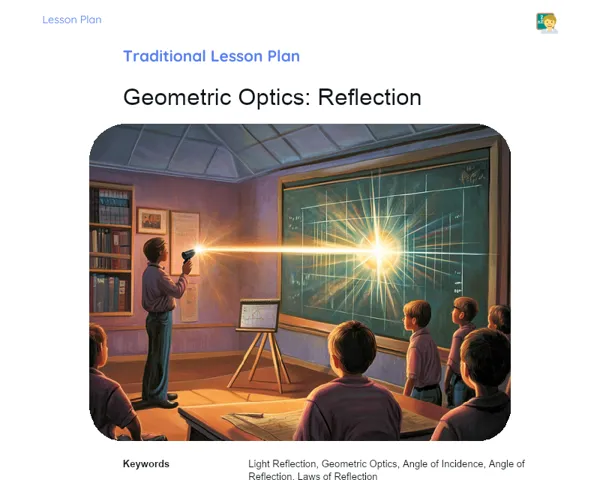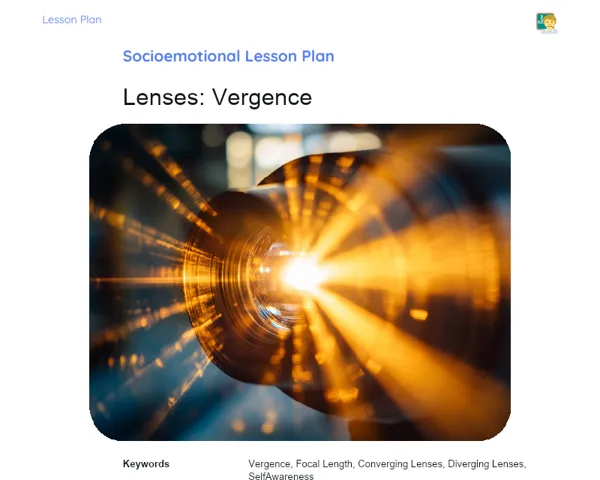Lesson Plan | Lesson Plan Tradisional | Geometric Optics: Prisms
| Keywords | Geometric Optics, Prisms, Snell's Law, Angular Deviation, Refraction, Light Dispersion, Isaac Newton, Binoculars, Optical Instruments, Practical Problems |
| Resources | Whiteboard, Markers, Projector or digital board, Presentation slides, Glass prisms, Light source (laser or flashlight), Scientific calculators, Copies of exercises and problems, Ruler and protractor, Sheets of paper for notes |
Objectives
Duration: (10 - 15 minutes)
This segment of the lesson plan aims to provide a straightforward overview of the key objectives that learners should accomplish by the end of the lesson. This way, the teacher can guide the class in a structured and focused manner, making sure that learners grasp the essential concepts of Geometric Optics related to prisms and cultivate practical skills in applying Snell's Law and problem-solving.
Objectives Utama:
1. Clarify what prisms are and how light behaves as it travels through them.
2. Illustrate how to use Snell's Law to work out the angular displacement in prisms.
3. Tackle practical issues involving light beam deviations in prisms.
Introduction
Duration: (10 - 15 minutes)
🎯 Elucidate the aim of this stage. The introduction seeks to ground students in the lesson's theme, sparking their enthusiasm and intrigue. By laying out initial context and sharing captivating facts, students will feel more engaged and ready to tackle the complex concepts that will be discussed throughout the lesson.
Did you know?
🔍 Share a fun fact to pique students' interest. A striking use of prisms in everyday life is in optical devices, like those found in binoculars and periscopes. These tools make use of prisms to redirect the light path, enabling viewing at various angles without shifting the instrument. Additionally, Isaac Newton's famous experiment, which showed that white light comprises several colours, was conducted with a prism.
Contextualization
👩🏫 Kick off the lesson by breaking down the topic of prisms. Prisms are geometric solids that are vital in the realm of Geometric Optics. They are made up of two congruent and parallel polygon bases, with lateral faces shaped like parallelograms. In optical terms, prisms are employed to bend and break up light, separating it into its constituent colours. This effect, called dispersion, is crucial for understanding how light interacts with various materials.
Concepts
Duration: (40 - 50 minutes)
🎯 This stage aims to enhance students' understanding of Geometric Optics concepts related to prisms. By delving deeper into specific topics and solving practical problems, students will apply the acquired theory, use Snell's Law for angular deviation calculations, and grasp the light dispersion phenomenon. Additionally, this segment seeks to build analytical and practical skills crucial for resolving optical challenges.
Relevant Topics
1. Characteristics of Prisms: Clarify the geometric properties of prisms, highlighting their parallel bases and lateral faces shaped like parallelograms.
2. Refraction of Light: Discuss what refraction is, detailing the change in direction of light when it moves from one medium to another, and how this is applicable to prisms.
3. Snell's Law: Explain Snell's Law (n1 * sin(θ1) = n2 * sin(θ2)), which outlines the relationship between the angles of incidence and refraction along with the refractive indices of the materials involved.
4. Angular Deviation: Describe how to calculate a light beam's angular deviation as it passes through a prism, using Snell's Law.
5. Dispersion of Light: Discuss light dispersion, where different light wavelengths bend at various angles when moving through the prism, causing colour separation.
6. Practical Applications: Give examples of how prisms are used in real-world applications, such as optical devices (binoculars, periscopes, spectrometers) and Newton's notable experiment.
To Reinforce Learning
1. Calculate the angular deviation of a light beam entering a glass prism (n = 1.5) with an angle of incidence of 30° and emerging at an angle of refraction of 45°.
2. A white light beam hits a glass prism at a 40° incidence angle. Determine the angular deviation for red light (n = 1.52) and for blue light (n = 1.53).
3. Describe how prisms are utilised in binoculars to redirect the light path, allowing viewing at various angles.
Feedback
Duration: (15 - 20 minutes)
🎯 The aim of this stage is to review and solidify the knowledge gained by students throughout the lesson. By engaging in detailed discussions about the question solutions and involving students with reflective questions, the teacher ensures learners fully comprehend the topics covered and can apply them practically. This stage also fosters a collaborative learning atmosphere where students are encouraged to share their insights and questions.
Diskusi Concepts
1. 📘 Question 1: Calculate the angular deviation of a light beam entering a glass prism (n = 1.5) with an angle of incidence of 30° and emerging at an angle of refraction of 45°. 2. To approach this question, apply Snell's Law: n1 * sin(θ1) = n2 * sin(θ2). 3. First, work out the angle of refraction inside the prism: 4. n1 = 1 (the refractive index of air), θ1 = 30°, n2 = 1.5 (the refractive index of glass). 5. sin(θ2) = (n1 * sin(θ1)) / n2 6. sin(θ2) = (1 * sin(30°)) / 1.5 7. sin(θ2) = 0.5 / 1.5 = 1/3 ≈ 0.333 8. θ2 = arcsin(0.333) ≈ 19.47° 9. Next, calculate the angle at which the light exits: 10. n2 = 1.5, θ2 = 19.47°, n1 = 1 (air). 11. sin(θ3) = (n2 * sin(θ2)) / n1 12. sin(θ3) = (1.5 * sin(19.47°)) / 1 13. sin(θ3) ≈ 0.5 14. θ3 = arcsin(0.5) = 30° 15. The total angular deviation is calculated by finding the difference between the entrance and exit angles. 16. Angular deviation = θ3 - θ1 = 30° - 30° = 0° 17. Yet, since refraction occurred within the prism, the final calculation requires summing the internal angles to yield a larger actual deviation. 18. 📘 Question 2: A white light beam hits a glass prism at a 40° incidence angle. Find the angular deviation for red light (n = 1.52) and for blue light (n = 1.53). 19. For red light: 20. n1 = 1, θ1 = 40°, n2 = 1.52 21. sin(θ2_red) = (1 * sin(40°)) / 1.52 22. sin(θ2_red) ≈ 0.4224 23. θ2_red = arcsin(0.4224) ≈ 24.98° 24. For blue light: 25. n1 = 1, θ1 = 40°, n2 = 1.53 26. sin(θ2_blue) = (1 * sin(40°)) / 1.53 27. sin(θ2_blue) ≈ 0.4183 28. θ2_blue = arcsin(0.4183) ≈ 24.69° 29. The angular deviation will differ for each colour due to the varying refractive indices. 30. Red angular deviation ≈ 24.98° - 40° = -15.02° (considering the internal path). 31. Blue angular deviation ≈ 24.69° - 40° = -15.31° (considering the internal path). 32. These variations result in the dispersion of light. 33. 📘 Question 3: Describe how prisms are employed in binoculars to redirect the light path, allowing viewing at different angles. 34. In binoculars, prisms are used to invert images and elongate the focal length without enlarging the physical size of the device. 35. They reflect light internally, bending the light path multiple times. 36. This design allows binoculars to remain compact while still delivering significant image magnification.
Engaging Students
1. ❓ What are the roles of prisms in modern tech, beyond the examples covered?* 2. ❓ How did Newton's prism experiment transform our understanding of light?* 3. ❓ What other optical phenomena can be interpreted using Snell's Law?* 4. ❓ Are there limitations to using Snell's Law in the context of prisms? What might those be?* 5. ❓ Where else can we observe light dispersion in daily life, aside from rainbows?*
Conclusion
Duration: (10 - 15 minutes)
The purpose of this stage is to summarise and reinforce the main points discussed during the lesson, bolstering learners' grasp of the concepts tackled. By recapping the content, linking theory to practice, and spelling out the subject's relevance, the teacher guarantees that students leave the lesson with a clear and applicable understanding of the topic.
Summary
['The concept of prisms and their geometric traits.', 'The principle of light refraction and its relevance to prisms.', "Snell's Law and the relationship between angles of incidence and refraction.", 'Calculating the angular deviation of light beams as they traverse prisms.', 'The light dispersion phenomenon and the separation of colours.', "Practical uses of prisms in optical devices and Newton's experiments."]
Connection
The lesson knitted theory to practice by addressing the fundamental principles of Geometric Optics and applying these ideas to solve practical challenges. For instance, by determining the angular deviation of light beams through Snell's Law, learners could witness how theoretical formulas manifest as observable outcomes in the real world.
Theme Relevance
Grasping the study of prisms is vital for students' everyday lives, having practical applications in numerous modern technologies—including binoculars, cameras, and scientific instruments. Moreover, understanding light dispersion and colour is critical for various fields in science and engineering, impacting everything from the design of optical devices to the assessment of natural occurrences like rainbows.



